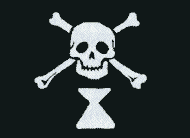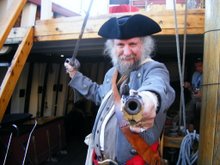Monday, December 31, 2007
The Spanish Main
The plot revolves around a Dutch captain, Laurent Van Horn, who is carried into Spanish waters by accident. The unsympathetic (and overweight) viceroy seizes his ship. When next we see Van Horn, he is navigator on a Spanish ship delivering Francesca, the Viceroy's bride. Van Horn flirts with her and earns a whipping. This is only partially carried out when the Spanish ship is attacked by the ship the Barracuda which in turn is captained by a mysterious man also known as the Barracuda. This, of course, turns out to be Van Horn.
He takes Francesca as his share of the profits and eventually marries her. This causes Anne Bonney to get jealous.
Eventually Francesca is delivered back to the Viceroy along with Anne and some other loyal members of the crew who are sentenced to be burnt. It is up to the Barracuda and his remaining crew members to rescue them.
According to the host on TCM, the original script called for a slave uprising and burning the town. RCO couldn't afford this and substituted a more sedate ending.
This is a typical pirate movie from the 1940s. The Spanish are the bad guys and pirates represent freedom and virtue. The Viceroy has no redeeming features. He is fat, lazy, and dishonest. A surprising number of pirates are also dishonest (surprising for a movie).
The ships look good although the captain's cabin is larger than the ship. The costumes are horrible. The acting is fairly good with Maureen O'Hara as Francesca.
One surprising bit of authenticity - you get a glimpse of someone steering with a whipstaff instead of a wheel (the ship's wheel was invented in the 1690s). This is almost unheard of bit of accuracy.
Saturday, December 15, 2007
Captain Kidd's Ship
The underwater archaeology team, from Indiana University, says they have found the remains of Quedagh Merchant, actively sought by treasure hunters for years.
Charles Beeker of IU said his team has been licensed to study the wreckage and convert the site into an underwater preserve for the public.
It is remarkable that the wreck has remained undiscovered all these years given its location, just 70 feet off the coast of Catalina Island in the Dominican Republic in less than 10 feet of seawater.
"I've been on literally thousands of shipwrecks in my career," Beeker said. "This is one of the first sites I've been on where I haven't seen any looting. We've got a shipwreck in crystal clear, pristine water that's amazingly untouched. We want to keep it that way, so we made the announcement now to ensure the site's protection from looters."
The find is valuable because of what it could reveal about William Kidd and piracy in the Caribbean, said John Foster, California's state underwater archaeologist, who is participating in the research.
Historians differ on whether Kidd was actually a pirate or a privateer — a ship or captain paid by a government to battle the enemy. After his conviction of piracy and murder charges in a sensational London trial, he was left to hang over the River Thames for two years.
Historians write that Kidd captured the Quedagh Merchant, loaded with valuable satins and silks, gold, silver and other East Indian merchandise, but left the ship in the Caribbean as he sailed to New York on a less conspicuous sloop to clear his name of the criminal charges.
IU Anthropologist Geoffrey Conrad said the men Kidd entrusted with his ship reportedly looted it and then set it ablaze and adrift down the Rio Dulce. Conrad said the location of the wreckage and the formation and size of the cannons, which had been used as ballast, are consistent with historical records of the ship. They also found pieces of several anchors under the cannons.
"All the evidence that we find underwater is consistent with what we know from historical documentation, which is extensive," Conrad said. "Through rigorous archeological investigations, we will conclusively prove that this is the Capt. Kidd shipwreck."
The IU team examined the shipwreck at the request of the Dominican Republic's Oficina Nacional De Patrimonio Cultural Subacuático.
"The site was initially discovered by a local prominent resident of Casa De Campo, who recognized the significance of the numerous cannons and requested the site be properly investigated," said ONPCS Technical Director Francis Soto. "So, I contacted IU."
Friday, December 7, 2007
Mythbusters - Pirate Myths II
I'm not sure how often someone was buried in the sand. A Blackbeard movie ended with the title character up to his neck in sand, waiting for the tide to cover him. Mythbusters proved that this would be fatal. You might be able to move a bit but the wet sand shifts and fills up any cavities.
The other two myths were using an upturned boat to walk underwater and the effectiveness of a cannon loaded with whatever junk was at hand.
I never thought that the scene with the upside down boat in PotC would work and Mythbusters proved this. They did stop short of making it work. This would have involved fastening anchors and other heavy weights to the boat until it was neutrally buoyant.
The final myth involved testing a cannon with various junk. In the movie the crew of the Interceptor was racing for shallow water and threw extra weight including cannon balls overboard. When it became obvious that they would be overtaken they loaded the cannons with whatever was left. While this gave them the satisfaction of fighting back, it was futile. Especially against undying pirates.
Mythbusters found that wood (a peg leg) and glass (a bottle of rum) were useless. Silverware didn't work at all but knives carefully packed in a canister were dangerous. A piece of chain was very effective. None of this should be a surprise.
Sunday, December 2, 2007
The Whydah
First of all, it is huge with 12 galleries. The exhibition not only includes the artifacts from the ship, it also includes a lot of information about the history of the ship (it was a newly-built slave ship) and the pirates aboard her when she wrecked off of Cape Code. There is even a full-size reproduction of the stern including the deck and captain's cabin and parts of the hold.
As for artifacts, they have everything you could ask for. The display begins with the ship's bell which is the proof that this is the Whydah. It had objects from everyday life, medical and carpenter tools. Most of the cannons are on display one way or another. A huge amount of treasure is on display with important individual pieces having their own display. Even the silk ribbon that a pirate tied to two of his pistols is displayed.
One surprise - one member of the crew was the youngest pirate on record - an 10 year old named John King. Surprisingly, his remains were the only ones found in the wreck and that only consisted of a leg bone and shoe.
Anyone who wants a peek into the life of real pirates should see this exhibition.

